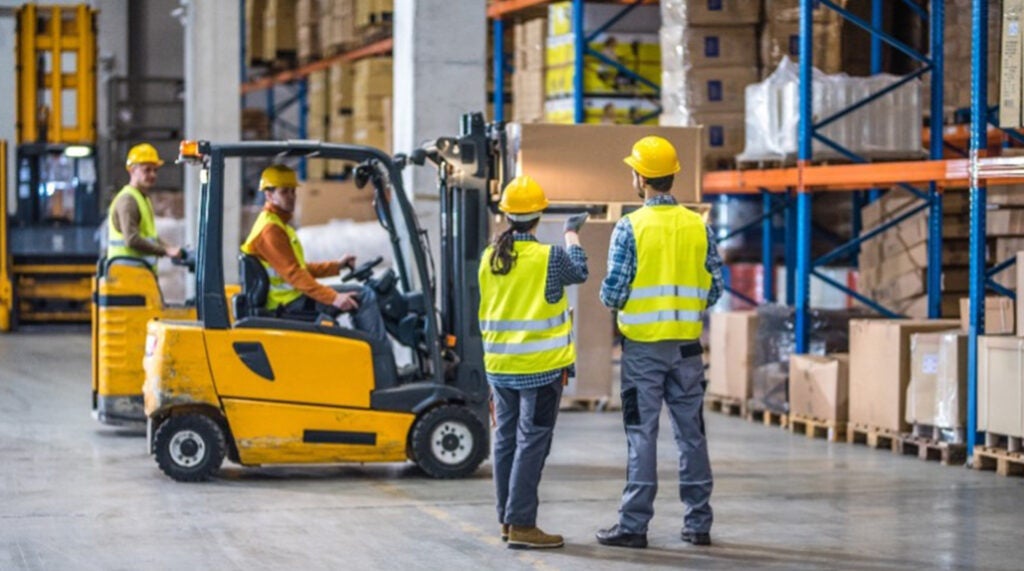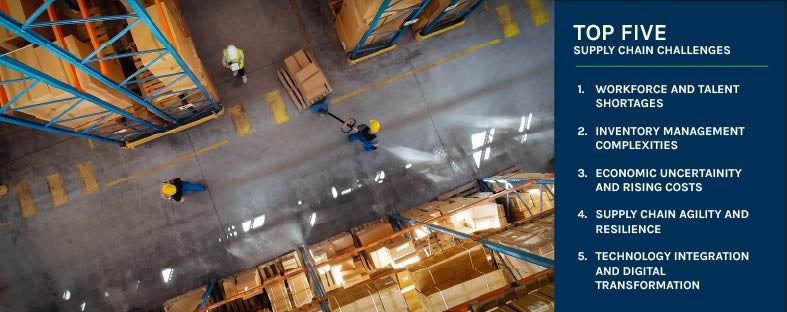60-Second Summary
Warehouse injuries cost companies billions annually, but automation is changing the safety landscape. From reducing repetitive strain injuries to eliminating dangerous manual tasks, automated systems like OPEX® Perfect Pick® are creating safer work environments while boosting productivity. Discover how five common warehouse safety hazards can be addressed through automation and learn how Perfect Pick’s ergonomic design and automated workflows are protecting workers across the industry.
An Emerging Trend in Safety
Heavy lifting, navigating around fast-moving equipment, working at dangerous heights, and performing repetitive tasks that gradually wear down the human body are more than just safety and compliance concerns. They serve as daily reminders of the responsibility to protect staff while operating efficiently.

The traditional approach to warehouse safety has focused on training, protective equipment, and procedural safeguards. While these remain important, a new standard is emerging: designing safety directly into warehouse operations through intelligent automation. Rather than simply managing risks, automated systems can eliminate many hazards entirely.
5 Critical Safety Challenges in Warehousing and How to Solve Them with Automation
1. Repetitive Strain Injuries and Ergonomic Hazards
Walk through any traditional warehouse and you’ll see workers constantly bending, reaching, lifting, and twisting. These repetitive motions, performed thousands of times per shift, create a perfect storm for injury. Back injuries, shoulder strains, and repetitive stress injuries don’t always happen overnight – they develop over months and years of accumulated stress on the human body.
The Solution:
Automated storage and retrieval systems (AS/RS), goods-to-person, and shuttle-based tote delivery systems fundamentally change this dynamic. Instead of workers traveling throughout the warehouse to retrieve items, automated systems bring products from storage directly to ergonomically designed workstations. In systems like Perfect Pick® and Infinity®, the optional Tote I/O capability extends these benefits by automatically moving totes between storage aisles and downstream processes through integrated conveyance. This removes the need for workers to shuttle totes in cold rooms, high racks, or other challenging environments, further reducing lifting, climbing, and exposure to harsh conditions. Workers remain in comfortable positions while the system handles movement, lifting, and transport of inventory. By eliminating excessive walking, awkward positioning, and repetitive reaching, automation significantly reduces the physical stress that can lead to long-term injuries.
2. Falls from Height and Equipment Related-Accidents
Traditional warehousing often requires workers to access high storage areas using ladders, scissor lifts, or other elevated platforms. Each time a worker climbs to retrieve an item, they’re exposed to fall risks that can result in serious injuries or fatalities. The US Department of Labor reports that falls from height, slips, and trips are among the top three causes of warehousing-related injuries.
The Solution:
AS/RS and goods-to-person systems eliminate the need for workers to access high storage areas. Robotic systems can safely navigate vertical storage structures, retrieving items from heights unsafe for human access and delivering them to ground-level workstations. When humans no longer need to work at elevation for routine tasks, the risk of falls drops dramatically. Workers can focus on ground-level activities while automated systems handle the dangerous vertical access.
3. Manual Material Handling Injuries
Heavy lifting remains one of the leading causes of workplace injuries in the warehousing industry. Even with proper lifting techniques and mechanical aids, the human body has limitations. Awkward load shapes, time pressure, and cumulative stress from repeated lifting create ongoing injury risks. The injury and illness rate in warehouses is more than double the all-industry average at 5.5 per 100 full-time workers, according to the US Department of Labor.
The Solution:
Robotic systems excel at handling heavy, awkward, or repetitive material movement. Automated guided vehicles (AGVs), robotic arms, and conveyor systems, when paired with AS/RS or goods-to-person systems, can move materials without fatigue or risk of injury. By removing humans from high-risk lifting scenarios, automation protects workers from both acute injuries and cumulative damage that develops over time.
4. Collision and Traffic Accidents
Pedestrians and material handling equipment often share the same spaces in warehouses and distribution centers. Forklifts, pallet jacks, and other powered equipment create collision risks, especially in high-traffic areas or during shift changes. According to the National Safety Council (NSC), 8,140 nonfatal forklift injuries are reported each year, with 79 forklift-related deaths occurring annually. The NSC also notes that forklift injuries result in an average of 16 days away from work, doubling the average of other injuries.
The Solution:
Automated storage and retrieval Automated pathways, intelligent traffic management systems, and designated work zones reduce the interaction between workers and potentially dangerous machinery. When automated systems handle material transport through dedicated pathways, workers can operate in safer, more predictable environments with reduced risk of collisions.
5. Fatigued Errors and Accidents
It’s no secret that physical warehouse work is intensely demanding. Long shifts, repetitive tasks, and the constant physical stress of manual material handling lead to worker fatigue. Tired workers make more mistakes, have slower reaction times, and are more prone to accidents. According to the Government Accountability Office (GAO), 85% of serious injuries in warehouses stem from manual material handling and ergonomic injuries, falls, and powered industrial truck and forklift incidents.
The Solution:
By reducing the physical demands of warehouse work, automation allows workers to focus on oversight, quality control, and decision-making tasks. Less physical exhaustion means better mental alertness and safer operations. Workers who aren’t physically drained can maintain better situational awareness and make safer decisions throughout their shifts.
Introducing OPEX® Perfect Pick®: Safety Through Intelligent Design
Understanding these industry-wide safety challenges, OPEX designed Perfect Pick as more than just an automated storage and retrieval system. It’s a comprehensive solution that prioritizes worker safety at every level. This goods-to-person system functions as a shuttle-based AS/RS and automated tote delivery system while eliminating hazards rather than simply managing them.
Robotic systems excel at handling heavy, awkward, or repetitive material movement. Automated guided vehicles (AGVs), robotic arms, and conveyor systems, when paired with AS/RS or goods-to-person systems, can move materials without fatigue or risk of injury. By removing humans from high-risk lifting scenarios, automation protects workers from both acute injuries and cumulative damage that develops over time.
Perfect Pick’s Key Safety Features
Ergonomic Present Stations:
Perfect Pick’s present stations reimagine how workers interact with inventory. Rather than forcing employees to adapt to awkward working positions, the system allows for comfortable access to its user interface and key components. Adjustable tote presentation height and angle enable customization of each workstation for individual workers. Totes are delivered directly to operators at the optimal height and angle for comfortable access. This eliminates awkward bending, reaching, and twisting associated with traditional item picking.
Automated Material Transport with iBOT® Robots:
One of Perfect Pick’s most significant safety innovations is minimizing manual material handling from routine operations. The system’s iBOT® wireless robots handle all tote movement within the system aisles. These self-charging iBOT robots navigate the system, retrieving totes from storage locations and delivering them directly to workstations. These robots operate continuously without human intervention, handling totes and trays up to 80 pounds per unit.
Controlled Access Systems:
Perfect Pick establishes clear boundaries between human work areas and automated operations, where robots are in motion, ensuring workers cannot accidentally enter hazardous zones during system operation. The automated storage areas are enclosed and secured, with access controls that prevent entry during operation. The system also includes safety interlocks and emergency stops to ensure worker protection. This reduces collision risks and exposure to automated equipment during normal operations.
Vertical Storage Design:
Perfect Pick’s vertical storage design creates fundamental improvements in warehouse safety by utilizing available space that’s often at heights unsafe to access by normal means. The system’s iBOT robots navigate heights up to 32’, so workers don’t have to climb that high to retrieve inventory and risk falling. High-density vertical storage also eliminates the need for extensive floor-based racking systems. This creates more open floor space with clearer pathways for workers, forklifts, and other vehicles. Having fewer obstacles means reduced collision risks and improved emergency routes.
Creating Your Safety-First Warehouse
Traditional approaches to managing safety risks, such as training and procedures, are important but have inherent limitations. As the need for more robust, high-volume warehousing grows, infrastructure must change to keep workers safe from strain and severe injury.
Perfect Pick represents a new approach: engineering safety directly into warehouse operations through intelligent automation. By eliminating hazards rather than simply managing them, the system creates inherently safer work environments while delivering the operational efficiency that modern supply chains demand.
Ready to create a safer warehouse environment for your team? Contact OPEX today to discover how Perfect Pick’s safety-focused design can enhance your operation while safeguarding your most valuable asset—your workers.
Other Resources You Might Find Helpful
Seamless Integration and Future Ready Automation with AI
Medical Record Scanning Demonstration with the OPEX Falcon+ Scanner
Falcon® Scanner Demo
Taking on Wisconsin Department of Transportation DMV’s Digital Transformation
Improving Payment Processing at Image Remit® a Division of Cash Management Solutions®
Legastat: When Flatbed Scanning is NOT Enough
How Intelligent Scanning Cuts Costs and Drives ROI for BPOs
Timaru District Council (TDC) Launches into a Digital World
Georgia Department of Revenue Accelerates Processing Times by Automating the Open, Prep, and Scan Process
Leon County Supervisor of Elections Overhauls Its Manual Document Process, Saving Money for Taxpayers
NEXT LEVEL AUTOMATION
Unlock Operational Efficiency with OPEX
OPEX is powering the future of automation. Contact us to learn more about how our vertically integrated automated solutions can help take your business to new heights.

